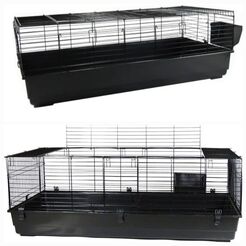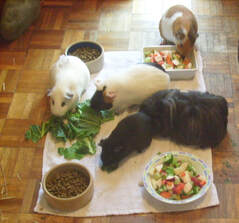A small insight to guinea pig care/keeping
Please bare in mind everyone cares for their animals differently, we do what works best for ourselves and our pets.
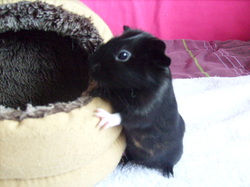
Guinea pigs make wonderful pets for children and adults, They can be kept indoors or outdoors thus making them suitable for many people. They are easy to handle and love to have human interaction. Like any social animal they love company from other guinea pigs so I strongly advise keeping at least two pigs together, (if and where possible). Sows (female guinea pigs) can live in groups. Boars (male guinea pigs) can be a little more difficult to pair, trio, quad but not impossible (iv often found sows a little more complex) ,If you have a single boar and want a friend for him, its best to get a young boar as this reduces the risks of fighting. Boars tend to be the more laid back pigs but saying this all pigs are different so no two rules apply in all cases. You can also keep a neutered boar with a group of sows, he often keeps the peace. Guinea pigs can live to between 4 - 8 years.
Guinea pigs should never be housed with rabbits, they have different dietary requirements and rabbits can cause serious damage to guinea pigs even if its accidental. A rabbits kick is known to fatally injure pigs. Rabbits can also carry Bordetella bronchiseptica which is the most common cause for respiratory infections in guinea pigs. The two species cannot communicate which can and does cause unnecessary stress on both animals.
Guinea pigs should never be housed with rabbits, they have different dietary requirements and rabbits can cause serious damage to guinea pigs even if its accidental. A rabbits kick is known to fatally injure pigs. Rabbits can also carry Bordetella bronchiseptica which is the most common cause for respiratory infections in guinea pigs. The two species cannot communicate which can and does cause unnecessary stress on both animals.
Guinea Pig Housing
** Solid flooring only for guinea pigs. Never house them on mesh/wire floors **

C&C Cages, (cage and corplast/proplex) They are very easy to build, move around and alter. They are also alot cheaper than your average hutch/cage. They are a metal grid which can be connected together to form a cage. The base is usually coroplast/proplex (a strong yet flexible plastic sheeting) Lino flooring can also be used and is just as good although not a solid.(lino has worked perfectly for me in the past). You must be aware that grids come in different sizes so care should be taken when getting the grid system as you wouldn't want your guinea pig getting their heads stuck. Please ensure grids are 9x9 squares or the rectangle shape.
It is also possible to buy c&c kits in full in many designs. These can have lofts and usually have the correx cut to size. Do shop around as prices vary hugely. Note all c&c cages come with clips, these are flimsy, I would advise cable tying all grids too for extra support.
It is also possible to buy c&c kits in full in many designs. These can have lofts and usually have the correx cut to size. Do shop around as prices vary hugely. Note all c&c cages come with clips, these are flimsy, I would advise cable tying all grids too for extra support.
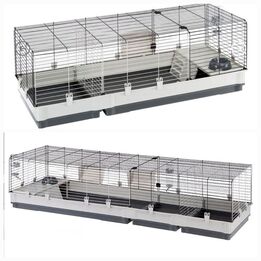
Pet store cages are usually on the small side and for the prices they charge your best looking online for alternative housing. I would always advise seeking information from a reputable source before spur of the moment buying a cage.(pet stores want to sell sell sell, sometimes giving false or inaccurate information) I find two story guinea pig cages unsuitable as more often than not the ramps are difficult for the pigs to get up and down, so to make these safe would need to be adapted. There is also the possibility of your guinea pig falling and injuring themselves.There are some good cages for sale out there but you have to search around. The ferplast range of cages are good value for money and often come in good sizes. See first image. This is the ferplast 140 and 160 range.
The second image is the little friends range, again in the 140 and 160 length.
The second image is the little friends range, again in the 140 and 160 length.

Hutches are another good way to keep guinea pigs, if not the most popular. Always ensure the hutch has a suitable latch to keep predators (cats, foxes etc) from getting at your pigs.. Keep the hutch out of direct sunlight, and sheltered from the wind. Also ensure you have a suitable cover for when it rains so the hutch remains dry. Make sure plenty of bedding is provided and the hutch is kept clean and dry. Shop bought hutches are often very flimsy and made from cheap materials and usually need fixed after a year or two of life. It may be worth sourcing a joiner or a specialized hutch builder to get a good quality long lasting hutch. Maybe even build your own.
Aslong as the hutches are kept clean, dry and free from drafts and lots of hay is provided then guinea pigs can live outside all year round. A companion is advised for added warmth/comfort.
I stay in Scotland, we often get very low temps and iv never lost a pig to the cold weather.
The hot weather is more of a concern than the colder weather.
Aslong as the hutches are kept clean, dry and free from drafts and lots of hay is provided then guinea pigs can live outside all year round. A companion is advised for added warmth/comfort.
I stay in Scotland, we often get very low temps and iv never lost a pig to the cold weather.
The hot weather is more of a concern than the colder weather.
Guinea Pig Bedding
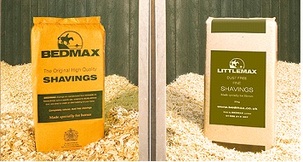
Cavy bedding can vary in price, comfort and how they look. Many people keep their pets on wood shavings, bedmax/littlemax This is perfectly ok to do and is one of the cheaper options. You can also use carefresh, medibed, aspen, auboise and Megazorb. You can also keep guinea pigs on flat newspaper with hay over the top, this usually needs changed every couple of days due to the paper getting wet. Soft straw can also be used. Some owners keep their cavies on vetbed, fleece and custom made liners. Some liners come with the absorbent layer sewn in others require the absorbent layer to be placed beneath the bedding. Ensure the cavy cannot get to the beneath layers. You must also ensure you clean the pen more frequently as fleece bedding can harbour the ammonia in the urine. This causes the smell and can cause issues with health. Please always ensure ample hay is provided at all times. Never restrict hay in racks/balls/wheels etc.
There are also many other beddings that can be used, its always worth sourcing a local equine/country store for beddings and hay/straw and even feed. Its often far cheaper than pet stores.
There are also many other beddings that can be used, its always worth sourcing a local equine/country store for beddings and hay/straw and even feed. Its often far cheaper than pet stores.
Feeding - * For More Info See The Dry Food Page *
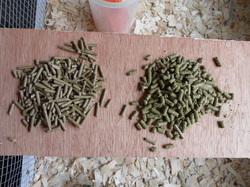
Pellets are often fed to prevent selective feeding. Muesli type feeds can encourage selective feeding, its best to assess your pigs as you see fit and decide what feed works best for you and your pigs. Along side pellets pigs should always have a fresh supply of hay, this helps to keep their teeth down and their digestive tract moving. If in doubt in how much to give them, just think hay hay hay!! Its very important. They must also have fresh water available. Guinea pigs also enjoy a wide range of fresh fruit and vegetables, please see the cavy safe foods section. Guinea pigs do not produce their own vitamin c (like humans) so we must ensure they are given vitamin c rich fruits/veggies, a pellet feed.
Bonding Guinea Pigs
Bonding Guinea Pigs
Bonding guinea pigs is a very simple thing to do given you get the basics covered. Please bare in mind that no matter how much we as owners would like guinea pigs to bond, some will not get along and that in itself is ok. We should never force animals to bond because it suits us. Sometimes pigs get along from a young age then the bond is broken when they hit the hormonal teen stage, again very normal and if they make it past the 10 month age then its likely the bond will remain formed. There will always be pigs who differ from the majority.
When bonding guinea pigs personality is key. Matching them well can lead to a simple and stress free introduction.
Litter mates do not always get along, this will not increase the success rate of bonding.
There are many ways to bond pigs and everyone has their own way of doing things.
Never introduce and separate pigs as this will likely cause stress on all involved. Doing this does not allow them to build a bond over time. Every time they are re introduced the bonding and hierarchy building starts from square one.
I do not advise introducing in a run or other area. You want to know if the pigs will bond and live together so the best place to introduce them is indeed the intended cage/hutch/pen you want them to live in.
Iv seen on several occasions owners bonding in a run and the pigs get along ok, when placed in their cage, they fight. Every new environment brings a new chance for the hierarchy of pigs to change.
Some owners feel more at ease allowing pigs to live side by side for a few hours to get used to each others smell, this is perfectly ok to do along as neither pig shows signs of stress by attempting to get at the other. There is no reason to house them next to each other for days or weeks, this does not increase the success rate of bonding.
When attempting to bond any pigs I always follow the following steps
It is totally normal for the pigs to chase, mount, chatter their teeth and rumblestrutt at each other. You may also notice hackles rising on their necks/backs. It is often a very vocal thing too.
If you have two or more pigs that are dominant you will notice they will face one another, chatter and lunge at each other, this is where if neither pig backs down a fight will occur. (tornado fight) Ensure you have something to hand to separate the pigs should this happen. A dustpan is handy as it enables you to block the pigs and keep your hands safe. Never reach in for either pig as you will likely get bitten.
If a fight happens and a pig is injured then separate and do not re attempt bonding.
Nipped ears and tufts of hair being pulled are all fairly normal. Do not separate pigs too early, it often looks and sounds much worse than it actually is. (especially with sows) The animals need to establish their roles in the pair/herd.
If you have a single adult pig it is usually best to attempt bonding with a youngster (6 - 8 weeks)
It is possible to bond adults but it can be a little more complex. Please seek the help/advice from a breeder/rescue for first hand help if unsure.
If you have a neutered boar he can be successfully housed within a herd of sows. Never more than 1 neut boar to a herd of sows. Exceptions to this do happen, in very large enclosures and many sows, more than 1 neut boar has been known to bond to the herd successfully. I do not advise attempting this if you are a new owner.
Note neutering a boar does not change their behavior, it merely means they cannot reproduce. If you risk the surgery then house him with sows.
When bonding guinea pigs personality is key. Matching them well can lead to a simple and stress free introduction.
Litter mates do not always get along, this will not increase the success rate of bonding.
There are many ways to bond pigs and everyone has their own way of doing things.
Never introduce and separate pigs as this will likely cause stress on all involved. Doing this does not allow them to build a bond over time. Every time they are re introduced the bonding and hierarchy building starts from square one.
I do not advise introducing in a run or other area. You want to know if the pigs will bond and live together so the best place to introduce them is indeed the intended cage/hutch/pen you want them to live in.
Iv seen on several occasions owners bonding in a run and the pigs get along ok, when placed in their cage, they fight. Every new environment brings a new chance for the hierarchy of pigs to change.
Some owners feel more at ease allowing pigs to live side by side for a few hours to get used to each others smell, this is perfectly ok to do along as neither pig shows signs of stress by attempting to get at the other. There is no reason to house them next to each other for days or weeks, this does not increase the success rate of bonding.
When attempting to bond any pigs I always follow the following steps
- Clean their proposed cage/hutch/pen thoroughly. You want to remove all scent. Making it a neutral space.
- Refill with fresh bedding, lots of loose hay scattered around, a few piles of veg/grass for distractions.
- NO hideys/toys/tunnels you dont want to give any pig anything to become territorial over.
- Place the pigs in the area and watch their body language, behaviors.
It is totally normal for the pigs to chase, mount, chatter their teeth and rumblestrutt at each other. You may also notice hackles rising on their necks/backs. It is often a very vocal thing too.
If you have two or more pigs that are dominant you will notice they will face one another, chatter and lunge at each other, this is where if neither pig backs down a fight will occur. (tornado fight) Ensure you have something to hand to separate the pigs should this happen. A dustpan is handy as it enables you to block the pigs and keep your hands safe. Never reach in for either pig as you will likely get bitten.
If a fight happens and a pig is injured then separate and do not re attempt bonding.
Nipped ears and tufts of hair being pulled are all fairly normal. Do not separate pigs too early, it often looks and sounds much worse than it actually is. (especially with sows) The animals need to establish their roles in the pair/herd.
If you have a single adult pig it is usually best to attempt bonding with a youngster (6 - 8 weeks)
It is possible to bond adults but it can be a little more complex. Please seek the help/advice from a breeder/rescue for first hand help if unsure.
If you have a neutered boar he can be successfully housed within a herd of sows. Never more than 1 neut boar to a herd of sows. Exceptions to this do happen, in very large enclosures and many sows, more than 1 neut boar has been known to bond to the herd successfully. I do not advise attempting this if you are a new owner.
Note neutering a boar does not change their behavior, it merely means they cannot reproduce. If you risk the surgery then house him with sows.
